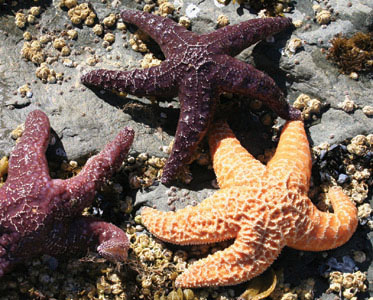Located along rocky shorelines, tidepools feature a vast array of aquatic life, from colorful sea stars to spongy sea cucumbers to vibrant anemones. Along California’s 1,000-mile coastline, waves pound the shore and tides surge and ebb. Tidepools are the pools of water left behind when the tides recede.

There are close to 1,800 species of sea stars, varying in size, shape and color. Sea stars are one of the rare creatures that are suited for the changing conditions that exsit in tidepools. Photo courstesy of Aquarium of the Bay
By Mallory Johnson
Published: March, 2014
Located along rocky shorelines, tidepools feature a vast array of aquatic life, from colorful sea stars to spongy sea cucumbers to vibrant anemones. Along California’s 1,000-mile coastline, waves pound the shore and tides surge and ebb. Tidepools are the pools of water left behind when the tides recede.
Life in a tidepool isn’t easy, and only specialized animals and plants survive. Tidepool residents must withstand hammering waves when the tides roar in, and blazing sun, harsh winds and freshwater rain when the tides creep out. Not just any creature can spend a day in these conditions and live to tell the tale. Possibly the most popular among tidepool creatures is the remarkable sea star.
For starters, sea stars are not fish, as they do not have gills, fins or a skeleton—thus the name sea star is more appropriate than the common nickname, starfish. In reality they are echinoderms, a radially symmetric marine invertebrate. There are close to 1,800 species of sea stars, varying in size, shape and color. Even the texture of their skin can vary from leathery to scaly or even prickly. All sea stars have a tough, spiny, calcified skin that comes in handy as a protective coating from predators, including birds, fish, and sea otters. The striking colors of the echinoderms are no mistake either. The various hues of sea stars help to camouflage them from potential attackers.
Another remarkable trait of sea stars is their multiple arms. Most sea stars have five arms, but some species, such as the sunflower star, can have up to 40. No matter the number of arms, each one contains rows of tiny tubed feet that operate hydraulically. Sea stars take in sea water through a sieve plate, or madreporite, on top of their body. Once they take in the water, they can channel it to their tubed feet, allowing their feet to extend. The sea stars then use tiny muscles and suction cups on the bottom of their feet to cling tightly to the rocks or to move gradually along the rocky terrain.
Here’s a neat trick. Chances are you’ve noticed a sea star upside down and wondered what happens to it. How does it get right side up? Do the waves eventually flip it over, or does it just stay like that and accept its new life as an inverted invertebrate? None of the above. It’s a simple solution, really—a sea star is able to rotate one arm and use its muscles to pull the rest of itself over.
Life in a tidepool could prove challenging for these cold-blooded organisms. Despite their numerous tubed feet and cool flipping tricks, their ability to move is still limited and they don’t maintain a consistent internal body temperature. Many sea stars spend their whole lives immersed in the cool comfort of deeper waters, never seeing the water’s surface. Tidepool sea stars, however, inevitably end up spending a decent amount of time exposed to the sun each day. In order to deal with these temperature fluctuations, these sea stars employ a coping mechanism known as thermoregulation. During periods of high tide when the pool is flooded, the sea stars will soak up the cold ocean water, using this surplus of water as a buffer when exposed to direct sunlight and warm water during low tides.
Northern California is an excellent place to take advantage of tidepools and the amazing wildlife found within them. Tidepools abound in the region and most are easily accessible to visitors who want to learn more about the magnificent flora and fauna living there. Another great place to learn all about sea stars and their tidepool companions is at Aquarium of the Bay, where guests are welcome to visit the California Tidepool touchpool and learn about these creatures from naturalists or during daily presentations such as tidepool feedings. To find out more about the tidepools at Aquarium of the Bay, visit www.aquariumofthebay.org.
Mallory Johnson is the Public Relations Coordinator for Aquarium of the Bay, a nonprofit organization dedicated to protecting, restoring and inspiring the conservation of San Francisco Bay and its watershed.

